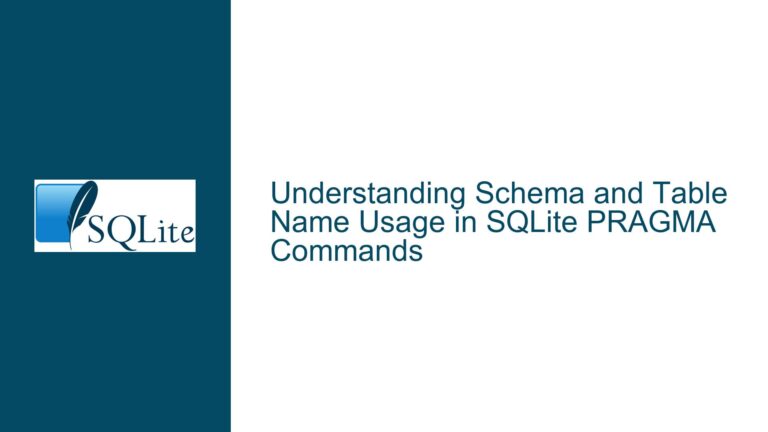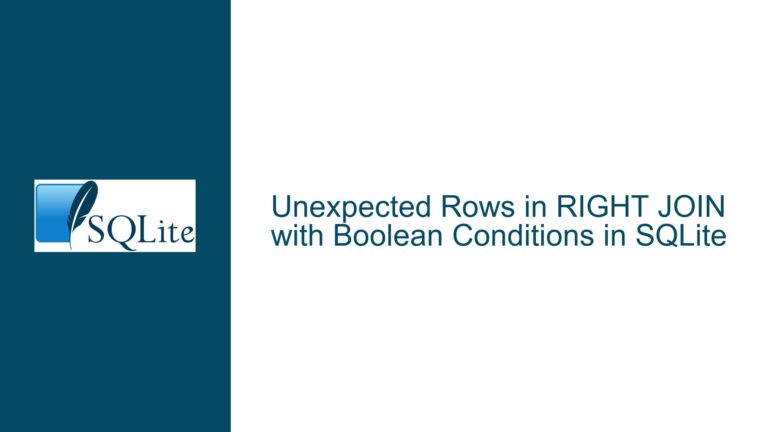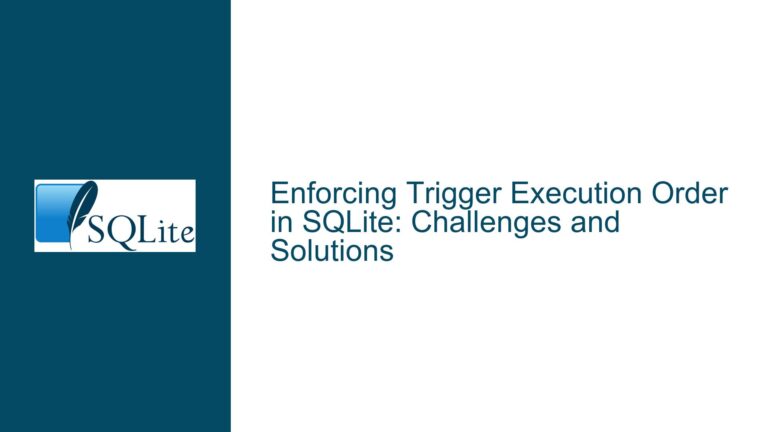WAL Mode Behavior with RETURNING Clause in SQLite
Issue Overview: Deferred WAL Writes on First sqlite3_step with RETURNING Clause
When executing an SQL statement with a RETURNING clause in SQLite, particularly in Write-Ahead Logging (WAL) mode, the behavior of the first call to sqlite3_step can be surprising. Specifically, the writes to the WAL file are deferred until the second call to sqlite3_step, contrary to the expectation that all database changes should occur during the first invocation of sqlite3_step. This behavior is observed when the database is in WAL mode, and it raises questions about the consistency of the documentation and the actual implementation.
The issue is particularly relevant for applications that rely on the immediate replication of database changes, such as those using custom in-memory VFS implementations. In such cases, the deferred WAL writes can lead to complications in ensuring that all database changes are replicated before returning rows to the client. This behavior is not immediately intuitive, especially given the documentation’s assertion that all database changes occur during the first invocation of sqlite3_step.
Possible Causes: Understanding the Interaction Between RETURNING Clause and WAL Mode
The root cause of this behavior lies in the interaction between the RETURNING clause and the WAL mode in SQLite. When a statement with a RETURNING clause is executed, SQLite treats it as a generator that produces rows. The database changes are indeed made during the first call to sqlite3_step, but the actual writes to the WAL file are deferred until the statement completes, which happens after the last row is returned and SQLITE_DONE is signaled.
In WAL mode, SQLite uses a combination of shared memory (SHM) and the WAL file to manage concurrent access and ensure durability. The SHM file is used to coordinate access to the WAL file, and the WAL file itself contains the changes that need to be applied to the main database file. When a statement with a RETURNING clause is executed, SQLite first acquires the necessary locks and barriers in the SHM file, but the actual writes to the WAL file are deferred until the statement is about to complete.
This deferral is a performance optimization that allows SQLite to batch multiple changes together, reducing the number of I/O operations. However, it can lead to confusion when the behavior is not explicitly documented, as in the case of the RETURNING clause. The documentation states that all database changes occur during the first invocation of sqlite3_step, but it does not clarify that the actual writes to the WAL file may be deferred until the statement completes.
Troubleshooting Steps, Solutions & Fixes: Ensuring Consistent Behavior with RETURNING Clause in WAL Mode
To address the issue of deferred WAL writes with the RETURNING clause in WAL mode, several approaches can be considered. These include understanding the internal mechanics of SQLite, modifying the application logic, and exploring potential workarounds.
1. Understanding the Internal Mechanics of SQLite:
The first step in troubleshooting this issue is to gain a deeper understanding of how SQLite handles statements with the RETURNING clause in WAL mode. As explained earlier, SQLite treats such statements as generators that produce rows. The database changes are made during the first call to sqlite3_step, but the actual writes to the WAL file are deferred until the statement completes.
This behavior is consistent with SQLite’s overall design philosophy of minimizing I/O operations and batching changes where possible. However, it can lead to unexpected behavior in applications that rely on immediate replication of database changes. To mitigate this, it is essential to understand the sequence of operations that occur during the execution of a statement with a RETURNING clause.
2. Modifying Application Logic:
One approach to ensuring that all database changes are replicated before returning rows to the client is to modify the application logic to buffer the rows until the statement completes. This approach involves capturing all the rows returned by the RETURNING clause and holding them in memory until SQLITE_DONE is signaled. Once the statement completes, the application can then replicate the database changes and return the buffered rows to the client.
While this approach introduces additional complexity, it ensures that all database changes are replicated before any rows are returned to the client. This is particularly important in distributed systems where consistency and durability are critical.
3. Exploring Potential Workarounds:
Another approach is to explore potential workarounds that force a page cache flush after the first call to sqlite3_step. One such workaround is to use the sqlite3_db_cacheflush function, which attempts to flush the page cache to disk. However, as noted in the discussion, this function may not be effective in this scenario because the page in question is still "used" by the statement being stepped.
An alternative workaround is to use the experimental application-defined cache feature, which allows the application to control the caching behavior of SQLite. This feature is not yet stable and may not be suitable for production use, but it provides a way to force a page cache flush after the first call to sqlite3_step.
4. Clarifying Documentation and Expected Behavior:
Finally, it is important to clarify the documentation to reflect the actual behavior of SQLite when executing statements with the RETURNING clause in WAL mode. The documentation should explicitly state that while all database changes occur during the first invocation of sqlite3_step, the actual writes to the WAL file may be deferred until the statement completes.
This clarification will help developers better understand the behavior of SQLite and avoid potential pitfalls when using the RETURNING clause in WAL mode. It will also provide a more accurate representation of the internal mechanics of SQLite, allowing developers to make informed decisions about how to handle database changes in their applications.
Conclusion:
The issue of deferred WAL writes with the RETURNING clause in SQLite’s WAL mode is a nuanced one that requires a deep understanding of SQLite’s internal mechanics. By understanding the interaction between the RETURNING clause and WAL mode, modifying application logic, exploring potential workarounds, and clarifying the documentation, developers can ensure consistent behavior and avoid unexpected issues in their applications.
While the deferred WAL writes may initially seem counterintuitive, they are a result of SQLite’s design philosophy of minimizing I/O operations and batching changes where possible. By taking a proactive approach to understanding and addressing this behavior, developers can leverage the full power of SQLite while ensuring the consistency and durability of their database changes.






